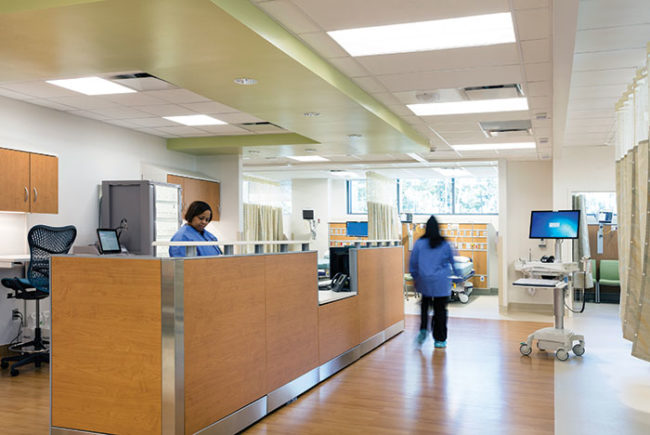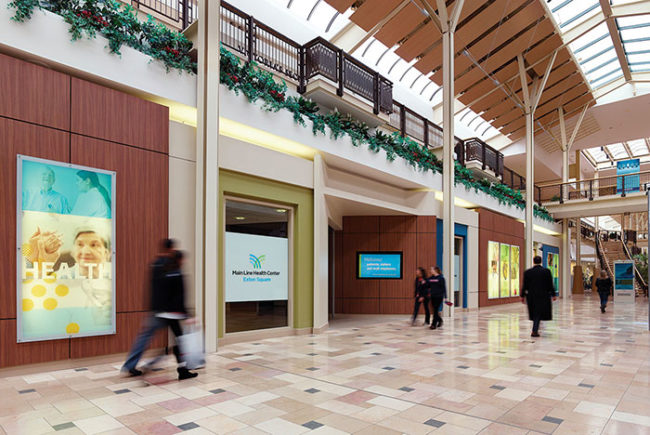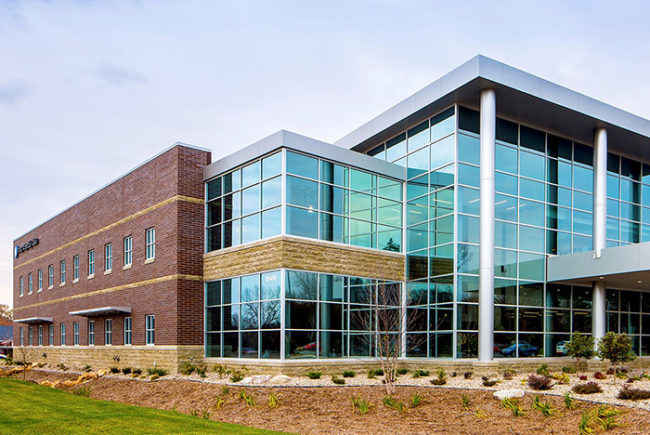
Site selection is one of the first and most important steps health care organizations take when embarking on the development of a new outpatient facility. More than just choosing a plot of ground, there are many factors that go into the selection of a facility site — from the size and cost of a parcel of land to its visibility, its proximity to other health care facilities and how quickly it can be developed. Site selection is a multifaceted issue that has the potential to impact the rest of a project and, eventually, the success of the resulting facility.
Particularly for health care organizations that have not built a new facility in the past, choosing a site and launching the development can be daunting. That’s why it is important to have a clear understanding of all considerations before beginning a site search. With the proper context and preparation, health care organizations can conduct a site-selection process that fits soundly within the project’s overall timeline, budget and vision for success.
Setting priorities
The first step in creating any new facility is setting a clear vision. Before identifying and reviewing properties, health care organizations must outline what they hope the completed facility will look like, how it will function, whom it will serve and its place in the broader area.
You may also like |
| Advice on leasing medical spaces |
| Keeping up with changes in health care real estate |
| Breathing new life into outdated sites |
|
|
For example, a health care organization developing an ambulatory surgery center may want to consider where its current or target patient base is located, how much case volume it anticipates, when it expects to open its doors and what, if any, additional ancillary services it may want to include in the building. These factors will help to shape everything from the size and layout of the facility to considerations for an optimal location.
With its vision set, the organization then can identify specific requirements for its facility site — essentially, the parameters for its site search. This can be as simple as creating a list of the elements or characteristics a site must have — or must not have — for it to be a contender.
For example, if a hospital is in desperate need of new and expanded medical office space to avoid losing existing tenants, finding a site that is shovel-ready may be the top priority.
By making a prioritized list of site-selection criteria, organizations can create their own rubric for quickly evaluating properties. However, they should be prepared for the likelihood that they may not find a property that checks all the boxes.
In many cases, organizations must weigh the pros and cons among imperfect sites and make compromises to fulfill their vision. That could mean buying a larger piece of property than desired because it’s in a good location, properly zoned and ready for development. Or, it could mean purchasing a property that needs variances from the local government because it’s ideally sized and located. This sort of balancing act is typical during the site-selection process for most projects.
4 Common criteria
To help identify ideal sites and weigh competing factors, many health care organizations choose to hire a development partner with the real estate expertise to quickly identify and rank properties based on an organization’s preferences. The most common criteria are:
1 Location, location, location
When setting priorities for a facility site, location is typically one of the most important factors to consider. Many projects are borne out of an organization’s strategic need to expand its services and presence into a geographic area — a town or neighborhood where their existing or potential patients live and work.
Rarely, however, would geographic limits be the only deciding factor for a property’s location. There tend to be other specific characteristics an organization wants when selecting a site.
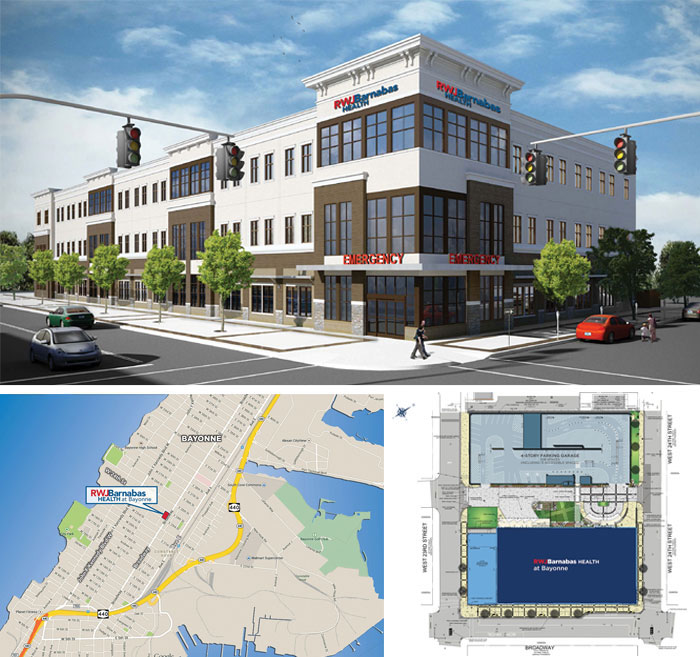
The urban site chosen by RWJBarnabas Health in West Orange, N.J., for a new ambulatory care facility required the demolition of older, mixed-use buildings and the construction of a parking structure.
Convenience, for example, is a common consideration for health care projects. Organizations usually prioritize ease of patient access to their facilities, making for a better overall patient experience and contributing to the likelihood that they will return and refer others. Those accessibility considerations include such factors as proximity to a highway interchange, position in or near a busy retail district, proximity to a desirable residential community and quantity and convenience of parking.
Similarly, high visibility may be a priority characteristic, particularly for an organization that would like to build its patient base. A building or storefront with prominent signage that gets plenty of visibility from passing traffic can help to build a health care organization’s brand.
Combined, the issues of convenience and visibility have become increasingly important to health care organizations in the past decade or so. Historically, health care organizations weren’t overly concerned with convenience — contending that people would be willing to travel to the destination of health care service, but that has changed.
Health care organizations now understand that consumers place a premium on convenience. Rather than driving downtown to the big hospital, patients may prefer visiting an outpatient location in their neighborhood, the same way that they prefer a neighborhood grocery store to one located across town. As a result, health care organizations are evolving their real estate strategies to make sure their facilities are situated within highly trafficked routes that already fit within their patients’ busy lifestyles.
Organizations also may consider proximity when looking at site locations. In fact, two of the biggest real estate trends among hospital facilities deal with this issue directly. On the one hand, many hospitals are concerned about proximity of their outpatient facilities to their main hospital location. They are reaching into their communities to essentially “ring” their territory.
For example, they may try to locate ambulatory surgery centers, physician practices, imaging locations and other facilities on properties that encircle what they consider to be their primary territory, providing a wide variety of health care choices for the people who live in that area.
On the other hand, some hospitals are moving to serve new areas — seeking out properties that traditionally have been beyond the organization’s reach. This essentially removes factors such as location and convenience from a patient’s decision-making process and instead focuses on factors like quality of the facility, expertise of physicians and ease of scheduling.
2 Size matters
The size of a development site is another fundamentally important factor. Ideally, health care organizations should choose a plot of land that can accommodate their current and projected square-footage needs, parking infrastructure and other considerations without a lot of excess acreage. Unless the organization has bigger plans for expansion, there’s no need to overbuy.
If an organization is partnering with a health care real estate development company, that partner should be able to estimate how much land a facility will need to accommodate the building’s square footage, parking, drainage and other considerations, such as potential future growth. This allows an organization to narrow its property choices to those that are the right size.
Of course, it sometimes happens that a health care organization is attracted to a site that is either too large or too small to perfectly accommodate its original vision. In the case of a too-small site that is otherwise ideal, it may try to adapt its development plan to make the facility fit the parcel.
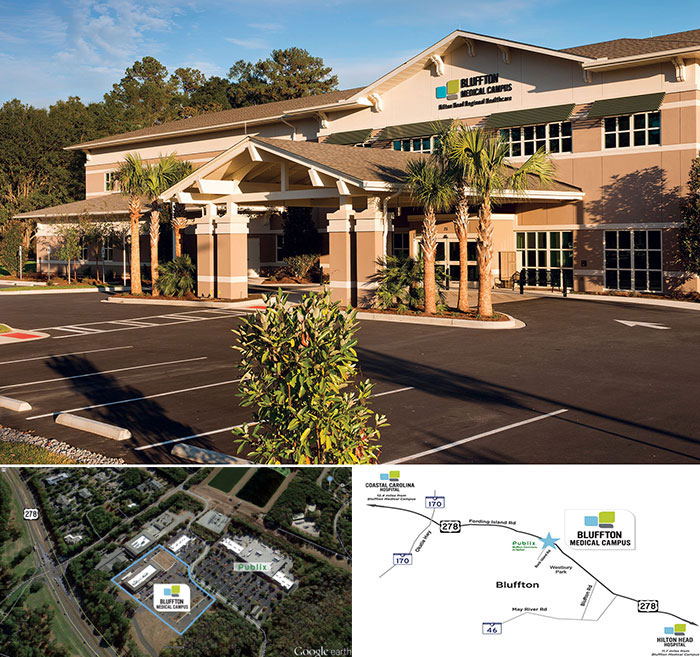
Hilton Head (S.C.) Health system chose a site located equidistant from each hospital on a high-traffic roadway in a busy retail center anchored by a prominent supermarket chain.
In this case, the organization may need to think creatively about its design and consider applying for variances to building codes to allow a building that is taller, for example, or that has less parking than existing building codes require. Alternatively, it may need to make some sacrifices in terms of which programs or practices the facility will house, asking the question, “Which program can I live without?” If the answer to that question is, “None of them,” it’s probably time to consider other sites.
For instance, RWJBarnabas Health in West Orange, N.J., was looking to expand into Bayonne, with an ambulatory care facility to provide the community with greater access to high-quality health care. Located along one of the busiest thoroughfares in downtown Bayonne, the projected site had great visibility and was situated in an area targeted by the city for redevelopment.
The facility opened earlier this year and includes a freestanding emergency department, imaging center and space for other planned clinical uses.
Developing a medical facility in an established and dense urban environment generally amplifies the cost and complexity of the project, the amount of governmental interaction and the number of required approvals. The Bayonne site contained several older, mixed-use commercial/residential buildings that had to be demolished as a part of the project. The urban location also required a multistory parking structure to meet its parking needs.
These circumstances required a steady focus on efficiency to contain costs as much as possible and a detailed strategy to secure the numerous approvals required on local, regional and state levels.
For properties that are too large, but otherwise desirable, health care organizations must calculate whether they can and are willing to pay the associated increase in cost. If so, they may want to hold onto the extra land for possible future expansion or development. If not, they could consider subdividing and selling parts of the property after purchasing the full parcel.
3 Cost controls
Property location and size are among the primary drivers of property costs. All other factors being equal, properties in the most desirable, convenient locations will cost more than their counterparts in more out-of-the way locales. In that way, an organization with a strict or tight budget may have to compromise on property location, size or both to make their vision a reality.
Additionally, the decision to purchase or ground lease a property can have a modest impact on site costs. Though there can be some economic benefit to ground leasing a property, owning and fully controlling the property is often a better decision for an organization in the long run. Generally, when layering in the land purchase cost and long-term ground lease expense, the difference usually is not significant.
Conversely, there can be a major cost difference between retrofitting an existing building and developing a new facility from the ground up. This is especially true when the project is a smaller retail facility, such as an urgent care center or primary care doctor’s office that the organization wants to locate in a high-traffic area. Retrofitting a former retail location, particularly if it had an open concept floor plan, can allow an organization to save money by taking advantage of existing infrastructure.
4 Speed to opening
An organization also may evaluate sites based on how quickly it would be able to complete the development and open its doors. Perhaps the organization wants to serve a new area quickly or perhaps it simply can’t wait any longer for the new or additional space.
When speed is important, the health care organization or its development partner may narrow the site search to include only those properties that are ready for medical development. That means properties that are the right size, have the proper zoning and no restrictions — allowing development to begin without an extended approval process or time-consuming zoning code changes or variances.
In addition, the organization should ensure that the site is free of any environmental concerns, such as wetlands, or remediation issues like underground storage tanks on the site of a former gas station. It can take a lot of time to manage these issues before a site is ready for development.
In some cases, however, several of these barriers may be overcome for the right parcel of land.
For instance, Hilton Head (S.C.) Health system partnered with a leading health care real estate firm to complete all facets of development of an outpatient facility needed in Bluffton, S.C., to support the operations of two hospitals within the system.
While there were numerous sites available, the preferred site was located equidistant from each hospital on a high-traffic roadway in a busy retail center. However, the site was slightly larger than needed and was located within a center anchored by a prominent supermarket chain that retained extensive rights to approve all future uses and development in the center.
These rights made negotiations and approvals even more complex than with other development projects. Also, the site contained federally protected wetlands — necessitating approval from the U.S. Army Corps of Engineers.
The premier location and great visibility of the site outweighed the competing factors based upon the health system’s priorities. Additionally, the hospital’s development partner negotiated with the site owner to minimize land costs and with the supermarket to secure approvals, while assembling all materials required to support federal, state and local approvals.
The process included numerous governmental meetings and several public hearings. With the complexity of the land acquisition and approvals, project development could have taken up to four years. However, with good planning and constant oversight, development was completed in slightly more than two years.
Streamlining selection
There are many factors to consider when evaluating properties for a potential health care facility. Usually, there is no perfect site and organizations must weigh their options.
By keeping these criteria in mind and measuring them against the predetermined priorities and vision for the development, health care organizations can streamline their site-selection process and choose the best site for their facilities.
Brian C. Cich is chief operating officer at Rendina Healthcare Real Estate, headquartered in Jupiter, Fla. He can be reached at bcich@rendina.com.



